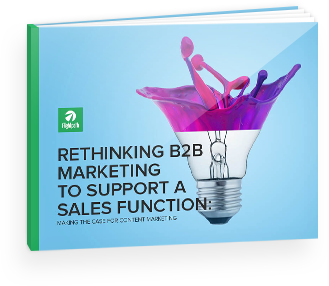1. Put your content strategy first, branding second. If you’re still marketing from the standpoint of building brand awareness, stop. No one cares about you, your products, your tagline, or your brand—at least, not yet. They care about the fact that they have a problem they must solve, and if they don’t, they might lose their job. If you can solve that problem, then they’ll talk to you. Today’s marketing must focus on digitally replacing some of the sales conversations that sales people used to be able to get on their own. And so the idea of mass marketing is out. People don’t want to be sold to, and they won’t tolerate disruption (which is why Netflix, HBO and Amazon are quickly replacing cable subscriptions.) Branding comes ONLY as a side benefit of a content strategy that focuses on thought leadership and creates experience. In other words, if your content is worth reading, they’ll watch out for your emails and blog posts, and may even reach out to you directly if they think you can solve their problem. And when it happens that way, it’s awesome. I’ve seen numerous situations where someone has read a blog post, picked up the phone, and became a client that day. But since they don’t all work quite that smoothly, you need to focus on lead intelligence, which brings us to:
2. Your conversions aren’t really providing lead intelligence.
People are coming to your website, reading your blogs, and downloading your white papers—but they’re not (and will never be) prospects. If that’s the case, the reason probably comes down to the fact that your conversion asset doesn’t provide any real lead intelligence. Your gated assets are your most powerful opportunities to convert anonymous web traffic into audience—but it can’t just be any piece of content. Obviously, the more value it provides, the better the leads—but that’s still not enough. Whatever it is, it must speak directly to the typical pain points a customer has (and that you can solve) so it triggers a sales conversation either now, or in the future. Remember, it’s not about volume, mass media marketing anymore—it’s about finding the individuals that are sitting at their desks, wondering how they are going to solve a problem. To start:- What are the things that keep your prospects up at night?
- What are some of the typical business challenges they face and are trying to solve?
- As they’re exploring solutions to those business problems, what are the things they’ll care about throughout their buying process? (For example, are they an early stage shopper, are they looking at vendors, or are they actually narrowing down their selection?)
3. Your content isn’t fully integrated with your sales process.
Speaking of typical pain points and buying triggers, if you’re not putting out regular content that speaks to these issues on a regular basis for readers to find, you’re missing opportunities. Usually, this happens when marketing still operates within the silo of branding and awareness rather than getting their content topics directly from sales. Sales people are at the front lines of customer and prospect interactions. They know what causes people to look for solutions like theirs, and if marketing isn’t helping to identify more at every stage of the funnel, sales is left to do it on their own, and will most likely miss quota. This won’t work if you’re just assigning blogs, articles and white papers as tactics to marketing. It requires an ongoing process of listening and developing content that meets the pains and objections of prospects on a regular basis. If marketing is producing content this way, and sales isn’t using it to open doors, then that’s another problem, which leads to:4. Sales and business development are not educated on how to use content to their advantage.
Vendors have far less control over the sales process than they used to. It’s a hard truth for the salesperson who always thought they were awesome at prospecting. They used to be the gatekeepers of information about the products and services from the company. But now, the buyer has significantly more control. They buy when they’re good and ready, and prefer to do research on their own before engaging with a sales person. But when they do, it’s usually a higher level of engagement. “Today’s buyers control their journey through the buying cycle much more than today’s vendors control the selling cycle,” Lori Wizdo from Forrester said. “In a recent survey, 74% of business buyers told us that they conduct more than half of their research online before making an offline purchase.” That has also led to the expansion of marketing’s responsibility for the full life cycle of the consumer, and the complexity brought on by all of the different channels. But one of the biggest mistakes that sales people make today is to simply reject marketing’s leads because they aren’t ready at that time to take a meeting. Building an engaged audience means that we’re nurturing prospects with relevant content over time, and when they’re ready, they’ll be receptive to your call. The bottom line for sales people is that it’s not about the number of touches anymore. It’s about how you use the lead intelligence collected by marketing in various formats to prioritize your outreach that will lead to sales conversations based on known problems that you can solve.5. You don’t have the right collection and analysis tools in place.
In the B2B world, if you’re just sending out emails and tracking open and click-through rates, you’re missing opportunities. For this whole thing to work, you need a marketing automation system combined with a Customer Relationship Management tool to track all digital behavior by that prospect over time. For example, as a sales person, I want to pull up a lead record in the CRM and see everything that prospect has engaged with. This information arms me with several follow up ideas based on what they’ve clicked that might lead to a sales conversation. I also know what else in my content library I have at my disposal to send them and nurture them down a path to buying. Here are some examples of what today’s B2B sales person wants to see for each lead record:- Web pages they’ve viewed, webinars they’ve attended, white papers they’ve downloaded, newsletter articles they’ve clicked on, etc. These things provide the sales person with an indication of what to talk about and provide insight.
- Once a qualifying sales conversation has taken place, who is involved in the decision? What’s their buying process? What’s their timeframe?
- How far down the sales cycle are they? Are they just starting to research or are they down to vendor selection?

